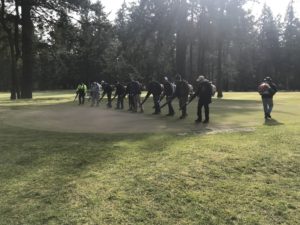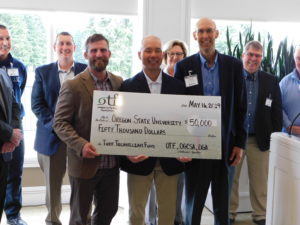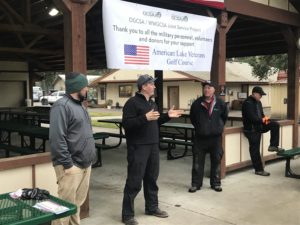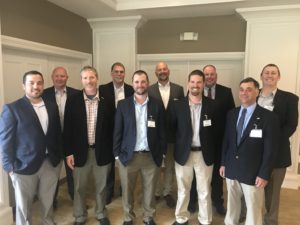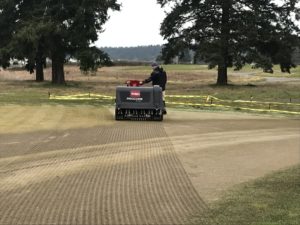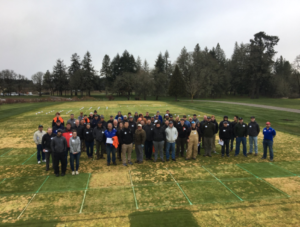ODA finds big problems with little organisms……
This information was sent out in a press release from the Oregon Department of Agriculture.
ODA finds big problems with little organisms
Fertilizer Program finds claims made for microbiological products aren‘t always met
June 1, 2016… Although a product may promise special ingredients, would you be willing to pay $150 if you knew all it contained was colored water? To help keep this from happening, the Oregon Department of Agriculture’s Fertilizer Program samples and analyzes products as part of its consumer protection role. Most recently, the program has looked at products that contain microorganisms– or at least claim to have them. The results of the analyses are less than encouraging.
“Some products have met the claim and have passed, but the percentage is very low,” says fertilizer enforcement specialist Toby Primbs.
ODA’s Fertilizer Program is the only one in the nation checking on ingredient claims made for microbiological products. The program began testing products claiming to contain beneficial bacteria and one type of beneficial fungi (Trichoderma) in 2013. Of the 51 products tested for bacteria, only nine met their guarantees. Of the 14 products tested for Trichoderma, none met their guarantees. Last year, the program began testing products with mycorrhizal fungi, which form partnerships with plant roots for mutual benefit. Of the 17 products tested, only three met the guarantees made on the product label.
“Many of these products are being sold at a premium price, yet nobody was looking to see if these microbes were actually in the product,” says ODA fertilizer specialist Matt Haynes. “We had anecdotal information that some products had nothing added despite what was said on the label. Once we started looking, more often than not, the companies making these products were not able to back their claims.”
As an example, a one-liter retail container of a fertilizer product that claimed to have both fungi and bacteria sold for $87.50, yet testing did not indicate the presence any of the microbes.
For the past three years, ODA has sampled end use products claiming to have these living organisms– whether they were found in bags of potting soil purchased at a garden center, taken off the shelf of a hydroponics store, or pulled from a 275 gallon container at a commercial fertilizer dealer.
“For us, it’s basic consumer protection, and the consumer isn’t just a homeowner or a farmer– it’s also the Oregon manufacturer who is buying these microbial ingredients to add to their product,” says Don Wolf, another ODA fertilizer specialist.
Once samples are collected, ODA’s Plant Health Laboratory does standard microbiology work to determine if the organisms exist at viable concentration as claimed on the label, or even if they exist in the product at all. In some cases, the organisms might have been there at one time but die off before the expiration date listed on the product label.
ODA’s Fertilizer Program has not been able to determine if intentional fraud has taken place or if the microbial products have simply been mishandled.
“There are many steps along the way before it gets to the end user,” says Primbs. “There could be problems with the original batch, with the mixing of the product, maybe it wasn’t stored correctly. These are living organisms, so a lot of them won’t do well under high heat or without food for long periods of time.”
Microorganisms are very important to agriculture. A spoonful of fertile soil typically has at least 50 billion microbes of 10,000 different species. Many of these bacteria and fungi are critical to vibrant plant growth, some help process nutrients to feed plants, while others may form partnerships with plant roots, providing raw materials and water to the plant, in return for carbohydrates.
Microbial inoculants aren’t new to agriculture. Since the nineteenth century, researchers have isolated microbes from the soil and plants with the goal of increasing crop production. Legume inoculants, to increase the growth of nitrogen-fixing bacteria so plants can grow their own nitrogen fertilizer, have been commercially available to farmers since 1897. Today, researchers have identified species containing a variety of characteristics with the potential to be even more useful to agriculture. Over the past several years, there has been great interest in, and a rapidly growing market for, microbiological ingredients. At least one published report estimates this rapidly developing market will be worth more than $4.45 billion worldwide by 2019.
Up until now, the results of the product sampling and analysis have been shared with the companies that produced them, as part of an educational approach undertaken by ODA.
“We have had a wide range of reactions by those who find out their product doesn’t meet the specifications that are claimed,” says Wolf. “Some are very concerned, very responsible, and want to do things right. Others seem to have only an interest in profitability and the bottom line.”
The educational approach is now transitioning to a regulatory one. Moving forward, any fertilizer product containing microorganisms found deficient by ODA will face enforcement action, ranging from a notice of violation to a potential civil penalty. The basis for ODA’s action is that the product would be deemed mislabeled if it can’t meet its claim.
“We hope these companies will look at their process and their final end use product so that they can ensure the customer is getting what is claimed on the label, all the way until the expiration date,” says Primbs.
ODA’s three-person Fertilizer Program continues to look at products for chemical and mineral content, also verifying label claims. With 10,000 fertilizer products registered by ODA for use in Oregon, and about 700 specifically containing microbial material, there is more than enough to keep the program busy. A dozen years ago, ODA registered only about 4,000 products and the program consisted of two people to cover the entire state. While the number of products grows in proportion to increased demand, the consumer protection function of the Fertilizer Program will only become more important.
ODA protects consumers through programs for food safety, animal health, pesticide use, invasive species, and weights and measures standards, among others. Add the fertilizer program to the list.
For more information, contact Toby Primbs, Don Wolf, or Matt Haynes at (503) 986-4635.
Link to article below.
http://odanews.wpengine.com/oda-finds-big-problems-with-little-organisms/








